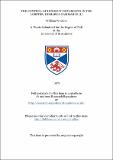The control of hindgut movements in the lobster, homarus gammarus (L)
Abstract
1. The mechanisms underlying hindgut movements in the lobster, Homarus gammarus (Lo) have been studied. 2. The hindgut is innervated from the sixth abdominal ganglion (6A.G.) by the posterior intestinal nerves (P.I.N.'s). Stimulation of any of the connectives of the ventral nerve cord (V.N.C.) will elicit hindgut and anal movements. 3. The hindgut is divisible into anterior and posterior regions, whose basic co-ordination is undisturbed by sectioning the hindgut, so long as the nerves remain intact. 4. Numerous endogenous oscillators mediating spontaneous contractions are thought to lie within the muscles of the rectum. Oscillators within the radial muscles of the anus can be activated by nervous discharge. 5. Receptors responding to anal dilation and closure have been described both anatomically and physiologically. They lie in the anal nerves. No physiological evidence exists for the presence of receptors on the rectum. 6. Hindgut and anal movements may be initiated by either 'phasic' or 'tonic' motor neurones. Bursts of tonic discharge will cause powerful hindgut movements (the defaecatory response), whilst those elicited phasically are rather weaker. The form of the bursting discharge is, apparently, immutable and is unaffected by extirpation of all sensory input. 8. The structure of the 6A.G. has been determined. It is a highly complex ganglion and it is suggested that it was derived from three fused ganglia in the course of evolution. 9. The somata of neurones causing efferent discharge to the hindgut have been shown to lie in the anterior part of the posterior ventral cortical lobe of the 6A.G. 10. Some of these neurone somata have been penetrated using glass microelectrodes. Three categories of neurones, responsible for hindgut control at the level of tine 6A.G., are thought to exist phasic neurones, tonic neurones and driver neurons. 11. The neurones within the 6A.G. represent a final motor pathway to the hindgut. These neurones are thought to be under the ultimate control of a centre lying in the tritocerebral region of the brain. Several interneurones connect the two.
Type
Thesis, PhD Doctor of Philosophy
Collections
Items in the St Andrews Research Repository are protected by copyright, with all rights reserved, unless otherwise indicated.

